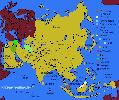|
|
|
|
|
|
|
|
|
|
|
|
|
|
| | |
|
|
|
|
| | |
| Name | latin |
Didymocorypha lanceolata |
| english |
Indian horned mantis |
| |
|
| | IGM-Number | 101 |
| |
|
| Systematics
Systematics
|
|
All data for the systematics is taken from Reinhard Ehrmann's book "Mantodea - Gottesanbeterinnen der Welt" (Mantodea - Praying mantids of the world).
More about this book can be found in the section literature at this page.
|

|

| Super-Order |
Dictyoptera |
| Order |
Mantodea |
| Family |
Tarachodidae |
| Subfamily |
Tarachodinae |
| | |
|
| | First Description | Author |
FABRICIUS |
| Year |
1798 |
| |
|
| Size
Quotation of Size
|
|
The given size is measured from the head to the end of the abdomen, without the wings.
|

|

| Male |
about 3cm |
| Female |
about 3,5cm |
| |
|
| Lifespan
Quotation of the Lifespan
|
|
The lifespan is given in month and has the following definition:
overall-age ("time between hatching and imago" + "lifespan after the last molting")
Example: 9 (2 + 7) month lifespan
overall-age = 9 month
time between hatching and imago = 2 month
lifespan after the last molting = 7 month
|

|

| Male |
about 6 (3 + 3) month |
| Female |
about 8,5 (3,5 + 5) month |
| |
|
| Sexing
Sexing
|
|
Morphologically differences between male and female.
|

|

| Male |
L5 and above: only by counting the abdominal segments at the bottom of the abdomen (8 segments)
adult: wings which cover about 3/4 of the abdomen, thinner and smaller than female, very long antennas |
| Female |
L5 and above: only by counting the abdominal segments at the bottom of the abdomen (6 segments)
adult: no wings, bigger and stronger shape than male, short antennas |
| |
|
| | |
 |
| adult male |
|
 |
| adult female |
|
| Spreading
Spreading
|
|
For a better overview, only whole countries are listed for the quotation of spreading, even if a species can only be found in a small part of that country.
All data for the spreading is taken from Reinhard Ehrmann's book "Mantodea - Gottesanbeterinnen der Welt" (Mantodea - Praying mantids of the world).
More about this book can be found in the section literature at this page.
At the menu "Spreading" for each country only the genus but the species is printed (Exception: on this site described species).
|

|

| India, Nepal, Sri Lanka |
| The description of this species is based on individuals of the following origin: |
| Goa (India) |
| |
|
| |
 |
| Asia |
|
| | Habitat | on Twigs, on bushes |
| |
|
| | Aggressiveness | low |
| |
|
| | Colorvariants | none |
| |
|
|
| |
|
|
|
|
|
|
|
|
|

